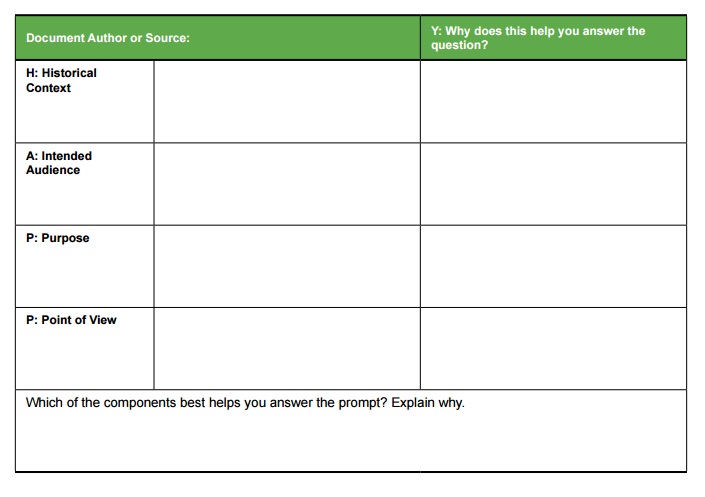
Essential Skills
| Skill |
Analyzing Historical Evidence: Primary Sources |
| Expectations |
Describe historically relevant information and/or arguments within a source. Explain how a source provides information about the broader historical setting within which it was created. Explain how a source’s point of view, purpose, historical situation, and/or audience might afiect a source’s meaning. Explain the relative historical significance of a source’s point of view, purpose, historical situation, and/or audience. Evaluate a source’s credibility and/or limitations. |
| Where you prove that you can do this on the exam | The DBQ, Short Answer, and Multiple Choice |
How we do this...

Extended Analysis of Documents
Note- MUST go beyond what is stated in the source line of the document and its content.
|
|
Author’s Point of View (POV)
|
Intended Audience |
Intended Purpose |
Historical Context |
|
Meaning |
Frame of Reference/Bias
|
Person and/or Group Targeted |
Goal, Reason or Motive |
Time and Place (Immediate) |
|
Things to Consider |
What about their identity causes them to say what they say?
-Profession -Social Class -Education -Race/Ethnicity -Culture -Sex/Gender -Region -Religion -Political Affiliation -Advocate -Law-abiding citizen -Leader -Opponent -Activist -Reformer -Supporter -Defender -Critic -In his/her opinion -In his/her eyes -Owners -Others?
How does this identity/factor specifically influence/impact the content of the document? |
For whom was the document created and how might this affect the reliability of the source?
-Fellow x… -Voters -Political Party -Independent or Undecided people -Reading public -Critics -Supporters -Leaders -Religious group -Economists -Women -Minorities -Recipient of communication -News media -Delegation -Others?
|
Why was the document created?
Why was it produced at the time it was produced?
-Persuade -Influence -Support -Justify -Convince -Advocate -Motivate -Entertain -Inform -Explain -Teach -Inspire -Criticize -Critique -Defend -Convert -Record -Request -Describe -Argue -Oppose -Attempt -Emphasize -Appeal -Vocalize -Make -Condemn -Others? |
When and where was the document created?
How might this affect the meaning?
How does it relate to the “big picture?”
-During or after a time of _______ -Historical Events -Broader regional, national, or global processes and trends -At the height of ______________ -Certain decade -Connections -Ties to _______ -War -Supreme Court case -Others? |
|
Basic Sample |
“The author’s POV was _____” and “is shown by _____” |
“The author’s intended audience was_____” and “is shown by _____” |
“The author’s purpose in writing was to _____” and “is shown by _____.” |
“The historical context of this document is _____.” |
|
Better Sample |
As a politician seeking reelection, he wanted to discuss policies believed to be popular with voters. |
His candid words were not surprising since he was directly addressing supporters at a fundraising event for his political party. |
He sought to convince undecided voters by identifying common ground with them right before the election. |
As someone running for political office in the U.S. during the heightening of the Cold War in the 1950s, he wanted to come across as a strong anticommunist. |
|
Best Sample
|
|
|
|
|